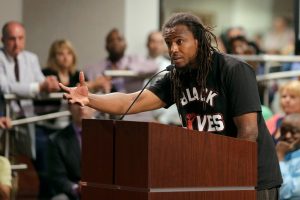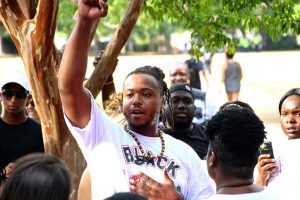In February, 2017, Muhiyidin Moye leaped across police tape to remove a Confederate flag from the hands of a Demonstrator in Charleston, South Carolina– and it was captured on national live television. A prominent Black Lives Matter activist, Moye took an intersectional and local approach to his work, rising in protest in Mount Pleasant against Trump’s attempted Muslim ban, and speaking vehemently about the structural inequality and history of white terror that led to the murder of nine black churchgoers in Charleston in June 2015.

I first heard about the recent death of Moye as I scrolled through Facebook, and saw a headline from The Hill– “Black Lives Matter leader gunned down in New Orleans.” This, firstly, is a testament to how technology has the dual potential both inform us and to trivialize and simplify human life– and death. I scrolled through some of the comments and was disgusted. In order to value and honor the life of Moye, I will not repeat any of those comments here. But I will say that those comments– and the overall coverage of this homicide in the media– is a testament to the nature of conscripted performance.
In “Echoes in the Bone,” Joseph Roach asserts that “Violence is the performance of waste.” In class, we dissected this, and realized that performers can be both conscripted and voluntary enrolled. The comments on the Facebook post, and the overall lack of widespread coverage of this murder, conscripts Moye into a racialized performance– a performance of radicalism, of disorder, and of other essentializing adjectives. In the reaction to the media coverage of his death, Moye is conscripted into a performance not of his humanism and activism, but of what people fear about his activism, his racial identity, his uncompromised fervor– and ultimately, his citizenship.
Furthermore, the media decontextualized New Orleans, the death place of Moye, as an effigy. But this effigy is one lacking in historical, local, or cultural substance, and it can be encapsulated in excerpt from the New York Times: “The incident is the subject of an active and ongoing investigation,” said Beau Tidwell, a spokesman for the New Orleans Police Department. New Orleans has one of the highest murder rates in the United States, with 157 murders in 2017.” In this picture of New Orleans– not like one of Unfathomable City, which celebrates music, culture, and ultimately, life– the city becomes fathomable in its essence of death, murder, and destruction. In the post-Katrina era, this statement turns New Orleans into the monolith similar to the one that was created during the aftermath of the hurricane. In this way, like Moye, New Orleans is conscripted into a performance.
It is important not to let these academic discussions of sensitive topics involving death, remorse, and memory to cloud our humanity. Overall, I think it is important that we take a few moments this week to reflect on the important vital organizing work of Muhiyidin Moye, and celebrate his life.

